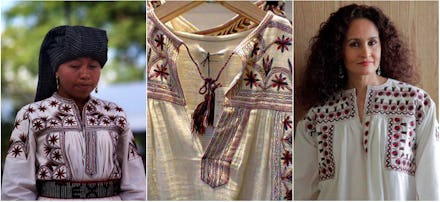Indigenous Women Are Fighting Back After a Famous Fashion Designer Stole Their Culture

An indigenous community of women from Mexico is considering legal action against French designer Isabel Marant for a design they say bears a striking resemblance to their traditional costume, according to a Guardian report.
The design in question is a cotton-muslin dress from Marant's Étoile line featuring an embroidered pattern that strongly resembles the designs created by the women of Santa Maria Tlahuitoltepec in Oaxaca, Mexico, often seen on traditional huipil blouses.
The community of women from Tlahuitoltepec view the design as inherent to their identity and are seeking reparations as well as asking that Marant remove the design from her collection, according to the Guardian.
Members of the community held a press conference in Mexico last week in which they stated, "Isabel Marant is committing a plagiarism because the Etoile spring-summer 2015 collection contains the graphical elements specific to the Tlahuitoltepec blouse, a design which has transcended borders, and is not a novel creation as is affirmed by the designer," according to the Guardian.
The words on everyone's lips in the case, of course, are "cultural appropriation." In this case, while the huipil is not reserved for particular communities (anyone can wear the tunics), the Marant controversy illustrates the thin line between design inspiration and plagiarism. Moreover, in this case, who holds the copyright to a design that is hundreds of years old?
Inspiration vs. plagiarism: The issue first gained traction on the Web earlier this year when Susana Harp, a singer from Oaxaca, tweeted side-by-side photos of Marant's design and the huipil. She called the design plagiarism.
In a video posted in May on Facebook, Harp further explained that she had first stumbled on the dress in a Neiman Marcus store in the United States and immediately recognized the pattern from Oaxaca. Harp says she was initially overcome with joy at the thought of seeing a department store with high-end designers carrying a design created by indigenous communities in Mexico.
"To my surprise, the first thing I saw was that it was under the label of designer Isabel Marant. And the second moment of sadness came when I found it said 'made in India.' It wasn't even made in Mexico," she says in Spanish in the video.
That's when she tweeted the photos, which prompted other users to echo their frustrations by using the hashtag #MiBlusaDeTlahui, which translates to "My blouse from Tlahui," a reference to the provenience of Mexico the design is found in.
What counts as appropriating: The dispute over the Marant design highlights a distinct kind of fashion cultural appropriation, one where the issue is not about who can wear the clothing, but who gets credit and who profits.
Other cultures may surely be used as design inspiration, but as Remezcla pointed out in May, the description accompanying the dress online fails to mention Oaxaca or the huipil, instead relying on the vague phrase "bohemian appeal."
To Harp's point about the item's "made in India" label, the best cultural inspiration happens when the new product maintains an authentic, real-life connection back to the original, whether that means being created in consultation with the original craftsmen behind a product or manufactured in that community. As Jessica Metcalfe, creator of a Native American fashion blog and store, previously told Mic, "When you're working with an individual on a collaboration, then you can learn a lot more of the nuances, like the differences between the communities."
In fact, Erasmo Hernandez, mayor of Tlahuitoltepec, told El Pais, "Tlahuitoltepec doesn't justify designer Isabel Marant's probable affinity with the blouse, and rather considers it an appropriation of a cultural heritage for commercial purposes... The villagers invite the designer to "meet the artisans and appreciate the everyday blouse to recognize the design's origins."
This is certainly not the first time a designer has been accused of plagiarizing a design from indigenous communities. In 2009, American designer Mara Hoffman released a design with a striking resemblance to a pattern produced by indigenous artisans in the state of Hidalgo, Mexico.
As for Marant, the brand reportedly stated, "For her part, Ms. Isabel Marrant does not claim to be the author of this tunic and these designs." Mic reached out for comment to Marant's offices but has not heard back as of publication.
But we have a feeling we'll be hearing more about the "Viola embroidered cotton-muslin dress" soon.
This post has been updated.